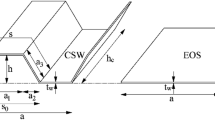Abstract
Concrete-filled arch ribs of concrete-filled steel tubular (CFST) arch bridges experience temperature effects and shrinkage/creep effects, as well as effects based on their interaction, that reduce the calculated stiffness of the arch ribs of the CFST arch bridges, resulting in a reduced bearing capacity. To address this problem, this paper proposes a Gaussian process response surface method based on the concept of dichotomy. When the training sample parameter interval is uncertain, it achieves the fastest retrieval of training samples that meet the requirements, it makes up for the shortcomings of the traditional small sample Gaussian process method. It can accurately predict the equivalent stiffness of the concrete-filled arch ribs of the CFST arch bridge, considering the effects of temperature and time, and grasp the time-varying degradation law of the mechanical performance of the CFST arch bridge arch rib. To verify the correctness and reliability of the proposed method, a refined analysis model of a CFST arch bridge is established using the general finite element software ANSYS, and the optimal creep equation and temperature effect function are selected. Using the improved Gaussian process model, the equivalent calculated stiffness of the arch rib filled with concrete after ten years under the combined action of shrinkage, creep and temperature effects of the concrete-filled steel tube arch bridge is predicted, and the deflection value and stability coefficient are proposed as the evaluation index of the prediction accuracy. The research results show that the proposed method provides a more simplified and high-precision method for the performance degradation analysis of concrete filled steel tube arch bridge arch ribs under the coupling action of complex factors such as shrinkage, creep, and temperature effects.








Similar content being viewed by others
References
Al-Negheimish, A.I., El-Sayed, A.K., Khanbari, M.O., Alhozaimy, A.M.: Long-term deflection of prestressed SCC hollow core slabs. Constr. Build. Mater. 189, 181–191 (2018)
Basudhar, A., Missoum, S.: Adaptive explicit decision functions for probabilistic design and optimization using support vector machines. Comput. Struct. 86, 1904–1917 (2008)
Canga Ruiz, A.E., Qian, Y., Edwards, J.R., Dersch, M.S.: Analysis of the temperature effect on concrete crosstie flexural behavior. Constr. Build. Mater. 196, 362–374 (2019)
Clark, L.: CEB-FIP model code 1990 (2008). https://doi.org/10.1016/0952-5807(95)90007-1
Das, S., Roy, S., Sambasivan, R.: Fast Gaussian process regression for big data. Big Data Res. 14, 12–26 (2018)
Fang, K.T.: Theory, method and applications of the uniform design. Int. J. Reliab. Qual. Saf. Eng. 9, 305–315 (2002). https://doi.org/10.1142/S0218539302000858
Guo, Z., Wang, Y., Lu, N., Zhang, H., Zhu, F.: Behaviour of a two-pinned steel arch at elevated temperatures. Thin-Walled Struct. 107, 248–256 (2016)
Huang, Y.Q., Fu, J.Y., Liu, A.R., Pi, Y.L., Wu, D., Gao, W.: Effect of concrete creep on dynamic stability behavior of slender concrete-filled steel tubular column. Composites, Part B, Eng. 157, 173–181 (2019)
JTG3362-2018: Code for design of highway reinforced concrete and prestressed concrete bridges and culverts (2018)
Lam, H.F., Ng, C.T.: The selection of pattern features for structural damage detection using an extended Bayesian ANN algorithm. Eng. Struct. 30, 2762–2770 (2008)
Lam, H.F., Hu, Q., Wong, M.T.: The Bayesian methodology for the detection of railway ballast damage under a concrete sleeper. Eng. Struct. 81, 289–301 (2014)
Li, Z.X., Yang, X.M.: Damage identification for beams using ANN based on statistical property of structural responses. Comput. Struct. 86, 64–71 (2008)
Li, F., Luo, Z., Rong, J., Zhang, N.: Interval multi-objective optimisation of structures using adaptive kriging approximations. Comput. Struct. 119, 68–84 (2013)
Li, X., Qiu, H., Chen, Z., Gao, L., Shao, X.: A local kriging approximation method using MPP for reliability-based design optimization. Comput. Struct. 162, 102–115 (2016)
Ma, Y.S., Wang, Y.F.: Creep of high strength concrete-filled steel tube columns. Thin-Walled Struct. 53, 91–98 (2012)
Naguib, W., Mirmiran, A.: Creep modeling for concrete-filled steel tubes. J. Constr. Steel Res. 59, 1327–1344 (2003)
Ni, Y.Q., Hua, X.G., Fan, K.Q., Ko, J.M.: Correlating modal properties with temperature using long-term monitoring data and support vector machine technique. Eng. Struct. 27, 1762–1773 (2005)
Sousa Tomé, E., Pimentel, M., Figueiras, J.: Structural response of a concrete cable-stayed bridge under thermal loads. Eng. Struct. 176, 652–672 (2018)
Wang, W., Gong, J.: New relaxation function and age-adjusted effective modulus expressions for creep analysis of concrete structures. Eng. Struct. 188, 1–10 (2019)
Wang, X.W., Pan, J.Y.: Evaluating aging coefficient x in age-adjusted effective modulus method. China Railw. Sci. 17(03), 12–23 (1996) (in Chinese)
Wang, Y.Y., Geng, Y., Chen, J., Zhao, M.Z.: Testing and analysis on nonlinear creep behaviour of concrete-filled steel tubes with circular cross-section. Eng. Struct. 185, 26–46 (2019a)
Wang, Y.Y., Geng, Y., Zhao, M-Z., Chen, J.: Non-linear creep modelling on circular concrete-filled steel tubular columns. J. Constr. Steel Res. 159, 270–282 (2019b)
Wu, B., Lin, L., Zhao, J., Yan, H.: Creep behavior of thin-walled circular steel tubular columns filled with demolished concrete lumps and fresh concrete. Constr. Build. Mater. 187, 773–790 (2018)
Yin, H., Fang, H., Wang, Q., Wen, G.: Design optimization of a MASH TL-3 concrete barrier using RBF-based metamodels and nonlinear finite element simulations. Eng. Struct. 114, 122–134 (2016)
Zhang, A., Zhang, L.: RBF neural networks for the prediction of building interference effects. Comput. Struct. 82, 2333–2339 (2004)
Zhou, Y., Sun, L.: A comprehensive study of the thermal response of a long-span cable-stayed bridge: from monitoring phenomena to underlying mechanisms. Mech. Syst. Signal Process. 124, 330–348 (2019)
Acknowledgements
The authors gratefully acknowledge the financial support provided by the Chinese Postdoctoral Science Foundation (grant 2016M600352), the Science and Technology Agency of Zhejiang Province (grant LGF19E080012) and the Science and Technology Project of Zhejiang Provincial Department of Transportation (grants 2019H14 and 2018010).
Author information
Authors and Affiliations
Corresponding author
Additional information
Publisher’s Note
Springer Nature remains neutral with regard to jurisdictional claims in published maps and institutional affiliations.
Rights and permissions
About this article
Cite this article
Lu, P., Li, D., Hong, T. et al. Concrete performance time-varying effect of CFST arch bridges. Mech Time-Depend Mater 26, 377–395 (2022). https://doi.org/10.1007/s11043-021-09492-2
Received:
Accepted:
Published:
Issue Date:
DOI: https://doi.org/10.1007/s11043-021-09492-2




